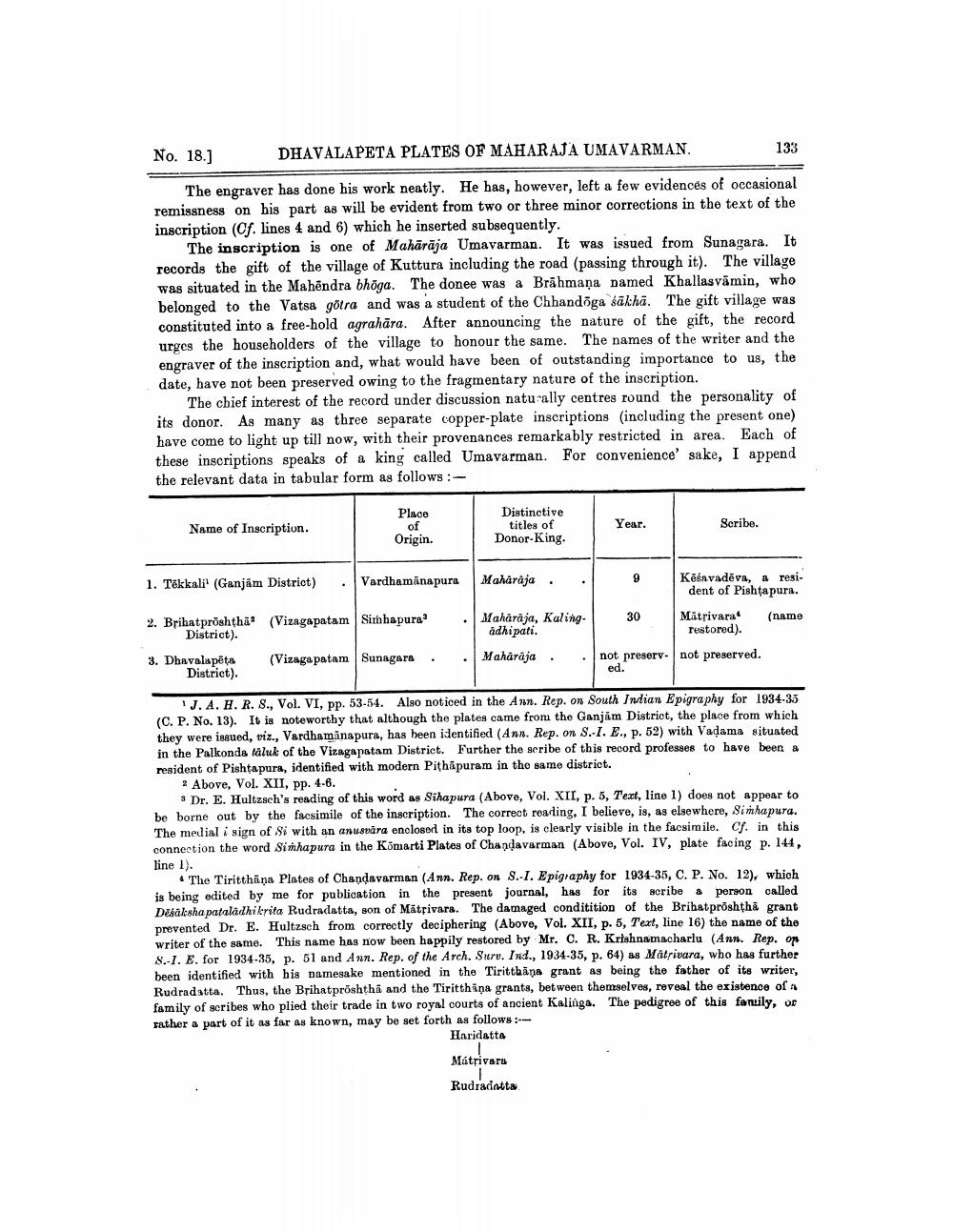________________
No. 18.]
DHAVALAPETA PLATES OF MAHARAJA UMAVARMAN.
133
The engraver has done his work neatly. He has, however, left a few evidences of occasional remissness on his part as will be evident from two or three minor corrections in the text of the inscription (Cf. lines 4 and 6) which he inserted subsequently.
The inscription is one of Mahārāja Umavarman. It was issued from Sunagara. It records the gift of the village of Kuttura including the road (passing through it). The village was situated in the Mahendra bhöga. The donee was a Brāhmaṇa named Khallasvāmin, who belonged to the Vatsa götra and was a student of the Chhandöga sākha. The gift village was constituted into a free-hold agrahāra. After announcing the nature of the gift, the record urges the householders of the village to honour the same. The names of the writer and the engraver of the inscription and, what would have been of outstanding importance to us, the date, have not been preserved owing to the fragmentary nature of the inscription.
The chief interest of the record under discussion naturally centres round the personality of its donor. As many as three separate copper-plate inscriptions (including the present one) have come to light up till now, with their provenances remarkably restricted in area. Each of these inscriptions speaks of a king called Umavarman. For convenience' sake, I append the relevant data in tabular form as follows:
Place
Name of Inscription.
of
Distinctive
titles of Donor-King.
Year.
Scribe.
Origin.
1. Tékkali' (Ganjam District)
. Vardhamanapura
Maharaja
.
.
Kēšavadēva, a resident of Pishta pura.
30
Matrivara restored).
(name
Maharāja, Kaling.
adhipati. Maharaja .
2. Brihatpröshtha. (Vizagapatam Simhapura
District). 3. Dhavalapēta (Vizaga patam Sunagara
District).
.
not preserv- not preserved. ed.
J.A. H. R. S., Vol. VI, pp. 53-54. Also noticed in the Ann. Rep. on South Indian Epigraphy for 1934-35 (C. P. No. 13). It is noteworthy that although the plates came from the Ganjam District, the place from which they were issued, viz., Vardhamanapura, has been identified (Ann. Rep. on S.-I. E., p. 52) with Vadama situated in the Palkonda taluk of the Vizagapatam District. Further the scribe of this record professes to have been a resident of Pishtapura, identified with modern Pithapuram in the same district.
? Above, Vol. XII, pp. 4-6.
3 Dr. E. Hultzsch's reading of this word as Sihapura (Above, Vol. XII, p. 5, Text, line 1) does not appear to be borne out by the facsimile of the inscription. The correct reading, I believe, is, as elsewhere, Simhapura. The medial i sign of Si with an anusara enclosed in its top loop, is clearly visible in the facsimile. cf. in this connection the word Simhapura in the Kömarti Plates of Chandavarman (Abovo, Vol. IV, plate facing p. 144, line 1).
• The Tiritthāņa Plates of Chandavarman (Ann. Rep. on S.-I. Epigraphy for 1934-35, C. P. No. 12), which is being edited by me for publication in the present journal, has for its scribe & person called Desaksha pataladhikrita Rudradatta, son of Mátrivara. The damaged conditition of the Bribatproshthi grant prevented Dr. E. Hultzsch from correctly deciphering (Above, Vol. XII, p. 5, Teat, line 16) the name of the writer of the same. This name has now been happily restored by Mr. O. R. Krishnamacharlu (An. Rep. on 8.-1. E. for 1934-35, p. 51 and Ann. Rep. of the Arch. Suru. Ind., 1934-35, p. 64) as Matrivara, who has further been identified with his namesake mentioned in the Tiritthāna grant as being the father of its writer, Rudradatta. Thus, the Brihatproshthi and the Tiritthāna grants, between themselves, reveal the existence of family of scribes who plied their trade in two royal courts of ancient Kalinga. The pedigree of this family, or Father a part of it as far as known, may be set forth as follows:
Haridatta
Mátsivars
Rudradotta




